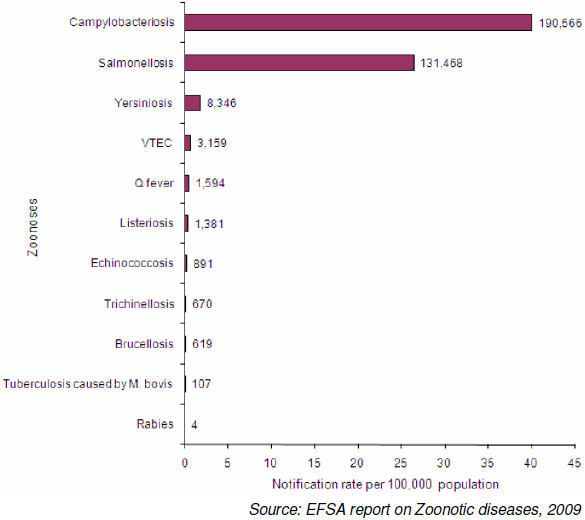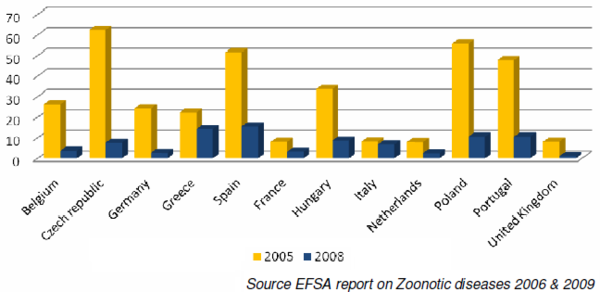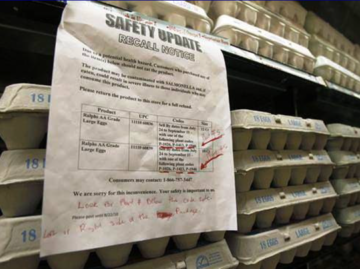...
-->Introduction
-->Conclusion
EUROPEAN UNION ZOONOSES CONTROL
By Dr Rick van Oort – Poultry Corporate Product Manager – Ceva Santé Animale
.
INTRODUCTION
Zoonotic disease are a major concern around the world as they are not solely affecting food producing animals but are influencing human health as well.
In Europe, the European Food Safety Authority (EFSA) has as task to monitor in all member states (27 countries), feed, animals and food products. Also EFSA monitors Food borne outbreaks and works on the Communicable human diseases with the European Centre for Disease prevention Control (ECDC).
The main zoonoses found in Europe are Campylobacter and Salmonellosis. The main sources of human Campylobacter and Salmonella Enteritidis (SE) and Salmonella Typhimurium (ST) are poultry products. These zoonosis are reported in the EFSA Report on Zoonosis, Zoonotic agents and Food borne outbreaks in the EU.
The latest report was published in 2010 and deals with the situation as of 2008.
Figure 1 Reported notification zoonoses rates in confirmed human cases in the EU, 2008
.
CAMPYLOBACTER
Campylobacter is the most commonly reported zoonotic disease with over 190.000 cases in humans. In food stuffs the main source was fresh poultry meat. Campylobacter is a difficult bacteria to control in poultry, but high bio-security and sanitation in poultry flocks can reduce the incidence.
.
SALMONELLA CONTROL
Salmonellosis is the second most reported zoonotic disease in the European Union with over 131.000 cases.
The trend in humans is decreasing mainly due to the more strict regulation including vaccination on Salmonella Enteritidis (SE) and Salmonella Typhimurium (ST) in layers and breeders. Breeders have strict regulation on SE and ST but also on Salmonella Hadar, Salmonella Virchow and Salmonella Infantis. SE and ST vaccination worldwide is an increasing trend and with the recent Egg recall in the US this trend will further intensify.
The EFSA carried out in 2004-2005 a base line study in which in all EU member states layer, broiler and breeder flocks were monitored for Salmonella infections. Based on the study outcome each member state has to reduce with a certain percentage the SE & ST infections for example in layer flocks each year. In order to achieve this reduction the EU has installed several regulations on controlling Salmonella and sampling protocols.
For layers the sampling and testing protocols are very detailed and involve many sampling moments of environmental samples during rearing and production period.
In 2009 the EFSA carried out a new survey on the infection rate of Zoonotic diseases in the EU. This report showed that levels of SE and ST in poultry flocks in many countries in the EU dropped significantly, showing that combined Salmonella control program consisting of monitoring, bio-security and vaccination works. On top of that, the human salmonellosis cases also show a decreasing trend.
Below is a graph comparing EU member states with over 10 million layers and their SE & ST occurrence over a 3 year period.
Graph 1 SE & ST positive layer-flocks EU in % (member states > 10 milion layers)
The overview below shows the reducing trend of human Salmonellosis cases (all serotypes) in Europe.
Graph 2 Human confirmed cases of Salmonellosis per 100.000 humans
Background of this comprehensive program is the increase of human salmonellosis cases in the UK in the late 80’s. This outbreak of human Salmonella cases that was linked to Salmonella contaminated eggs had a big effect on the poultry industry when egg sales dropped with 60% in the UK.
Graph 3 Trends in human Salmonellosis in England and Wales 1981 - 2006
.
CONCLUSION
The examples above show very clearly that a combination program of Biosecurity, Monitoring and Vaccination works in controlling Salmonella.
Nevertheless, the egg recall due to human salmonellosis cases in the US demonstrated that threat of this bateria is still very present in the poultry industry and it can deeply harm its image in front of consumers.
Figure 2 Notification on the egg recall in the US supermarkets
Therefore, all necessary efforts have to be made in order to provide safe and clean eggs to the market.
If you need to download this article, please do not hesitate to contact us!

 Corporate Website
Corporate Website
 Africa
Africa
 Argentina
Argentina
 Asia
Asia
 Australia
Australia
 Belgium
Belgium
 Brazil
Brazil
 Bulgaria
Bulgaria
 Canada (EN)
Canada (EN)
 Chile
Chile
 China
China
 Colombia
Colombia
 Denmark
Denmark
 Egypt
Egypt
 France
France
 Germany
Germany
 Greece
Greece
 Hungary
Hungary
 Indonesia
Indonesia
 Italia
Italia
 India
India
 Japan
Japan
 Korea
Korea
 Malaysia
Malaysia
 Mexico
Mexico
 Middle East
Middle East
 Netherlands
Netherlands
 Peru
Peru
 Philippines
Philippines
 Poland
Poland
 Portugal
Portugal
 Romania
Romania
 Russia
Russia
 South Africa
South Africa
 Spain
Spain
 Sweden
Sweden
 Thailand
Thailand
 Tunisia
Tunisia
 Turkey
Turkey
 Ukraine
Ukraine
 United Kingdom
United Kingdom
 USA
USA
 Vietnam
Vietnam









